
Edward Winter

Marcel Duchamp (1887-1968)
So much material is now available, in books and on-line, about the artist Marcel Duchamp that the present feature article confines itself to items which have appeared in Chess Notes.
***
Ed Tassinari (Scarsdale, NY, USA) writes:
‘In The Complete Works of Marcel Duchamp (New York: H.N. Abrahms, no date), Arthur Schwarz, in a generally interesting and informative chapter largely devoted to the chess career of Duchamp (which also contains several little-known games versus Marshall, Tartakower and Znosko-Borovsky among others), makes the following statement on page. 67: “... in 1967 and again in 1968 he coached the American team at the International Chess Tournament at Monte Carlo.” Somehow I don’t think that Fischer and Lombardy (1967) or R. Byrne and Benko (1968) exactly considered themselves a team; nor is it clear how Duchamp might have “coached” any of the American participants on either occasion.’
(1813)
This group photograph from the French Championship in Nice, September 1925 was published on page 179 of L’Echiquier, September 1925:
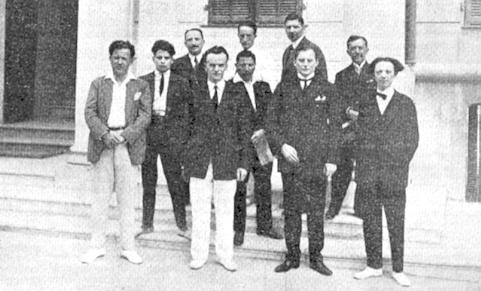
From left to right: A. Chéron, H. Bertrand, F. Lazard, R. Crépeaux, R. Gaudin, M. Duchamp, R. Casier, A. Alekhine, A. Silbert, G. Renaud
(3989)
Another photograph was published on the Supplément page of the September 1925 issue of L’Echiquier:
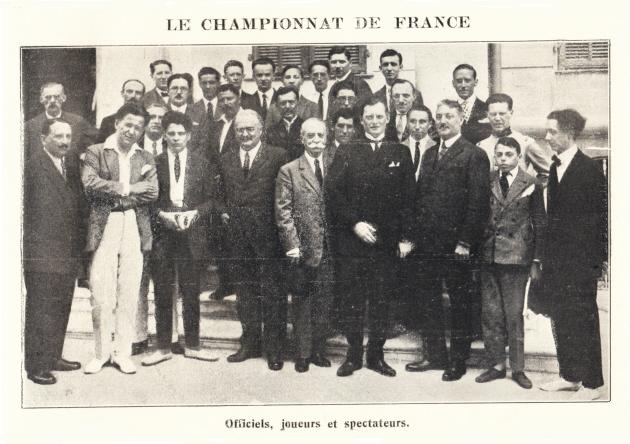
A fine individual shot of Alekhine, apparently taken around the same time, may be seen at the Gallica website.
(8235)
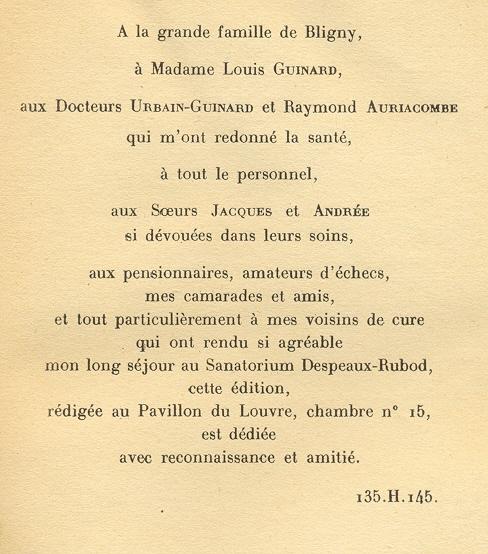
Above is the dedication page in Comment il faut commencer une partie d’échecs by E. Znosko-Borovsky. The book was first published in 1933, although the illustration comes from our copy of the fourth edition (1954). Further information about his illness and lengthy stay in the sanatorium would be appreciated.
The French version of the book was by Marcel Duchamp, and various editions have appeared in English, under the title How to Play the Chess Openings.
(4692)
This Nice, 1930 group photograph was published on page 68 of the April 1930 American Chess Bulletin:
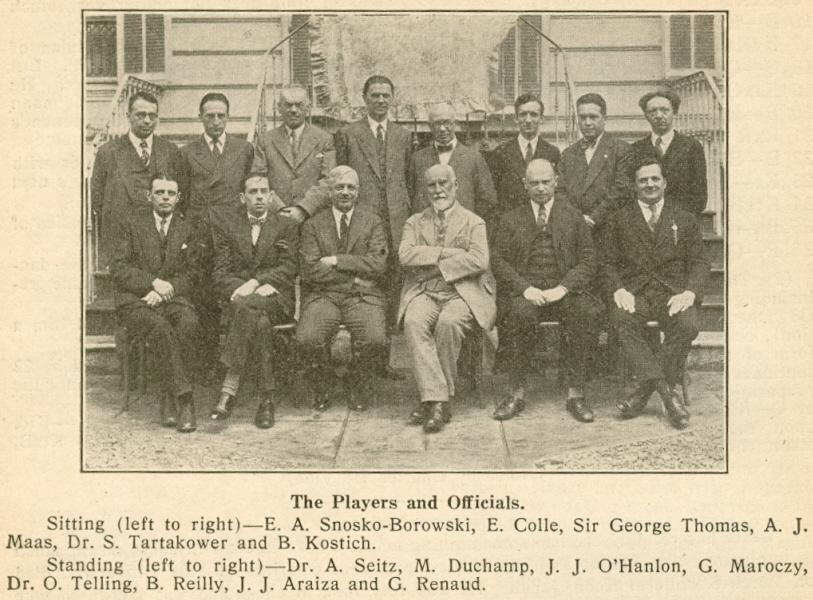
(5319)
A comment by us in C.N. 5820 about Treasure Chess by Bruce Pandolfini (New York, 2007):
Page 202 indicates that Marcel Duchamp lived to be 97 (‘1871-1968’) ...
Luca D’Ambrosio (Bolzano, Italy) asks who coined the term ‘cases conjuguées’, which is usually translated into English as ‘conjugate squares’ or ‘sister squares’.
He notes that the issue arose in a dispute on the pages of L’Italia Scacchistica and L’Echiquier in 1932. At the end of June the Belgian magazine brought out the book L’opposition et les cases conjuguées sont réconciliées by Marcel Duchamp and Vitaly Halberstadt. Pages 273-274 of the 15 September 1932 issue of L’Italia Scacchistica published a hostile unsigned article (later identified as written by Stefano Rosselli del Turco) accusing the co-authors of plagiarizing Contributo alla teoria dei finali di soli pedoni by Rinaldo Bianchetti (Florence, 1925). Among the charges was the following:
‘Nel nuovo libro si riscontrano infatti non solo molte delle idee e dei metodi escogitati dall’Ing. Bianchetti, ma perfino gran parte della terminologia da questi adottata. Inoltre l’essenza stessa del libro, contenuta nel titolo, non è altro che la contraffazione della dimostrazione fatta da l’Ing. Bianchetti che l’opposizione è un caso particolare delle case corrispondenti o reciproche, o, se si vuole, delle case coniugate.’
The full article was reproduced, in the original Italian, on pages 1810-1811 of the 3 November 1932 issue of L’Echiquier, together with a half-page denial of plagiarism by Duchamp and Halberstadt. They claimed to have given Bianchetti’s book due credit and stated that, in any case, the phrase ‘cases conjuguées’ predated Bianchetti, having been used by Przepiórka in Munich in 1908:
‘Par esprit d’équité historique nous devons reconnaître D. Przepiórka comme l’auteur de cette phrase si importante dans l’article cité: “L’opposition est un cas particulier des cases conjuguées.” Ceci se passait à Munich en 1908! La question des cases conjuguées n’est pas née en 1925.’
Mr D’Ambrosio asks what contribution Przepiórka made to the subject in 1908.
(6004)
From Harrie Grondijs (Rijswijk, the Netherlands):
‘On pages 24-25 of the second edition of my small book Four Endgame Studies by Emanuel Lasker (Rijswijk, 2008) I wrote that the Akademisches Monatsheft für Schach, May-June 1908 mentioned a talk by Dawid Przepiórka which I believe made it into print only in the Berliner Lokalanzeiger, although I have not seen what that newspaper published. I also noted that the talk was criticized by Johann Berger on pages 115-119 of the April 1909 Deutsche Schachzeitung. Berger referred to the principle of “eindeutige Beziehung”, which may be translated as “one-to-one relationship” and is not far removed from “conjuguées”. It is not clear to me whether Przepiórka used that particular phrase or whether Berger introduced it in his review.
Page 31 of my book gave the first use of the word “corresponding” in this context, from the start of a feature by C.D. Locock on pages 396-399 of the September 1892 BCM:
Finally, on page 34 I reproduced te Kolsté’s table with corresponding squares, from page 59 of the March 1902 Tijdschrift van den Nederlandschen Schaakbond.’
With regard to Przepiórka’s talk, can a reader trace what the Berliner Lokalanzeiger published?
(6011)
Philippe Frit (Toulouse, France) writes:
‘The contribution of Dawid Przepiórka to the theory of corresponding squares has been pointed out several times. In the introduction to his series of articles published in 1922-23 in Shakhmaty about “King manoeuvres in pawn endings”, Nikolai Grigoriev mentioned the names of only three predecessors or contemporaries who had become interested in the theory of corresponding squares (“теорию соответствия”): Dawid Przepiórka, Franz Sackmann and Siegbert Tarrasch:
Shakhmaty issue 3, September 1922, page 51 (see lines 6-8)
Transcription: Повидимому, уделяли им свое внимание люди с именем в шахматном мире, как, напр., Пшепюрка, Закман н наконец д-р Тарраш.
Translation: Famous people in the field of chess have apparently paid attention to it, examples being Przepiórka, Sackmann and finally Dr Tarrasch.
In 1932, the book by Marcel Duchamp and Vitaly Halberstadt Opposition et cases conjuguées sont réconciliées (Opposition and Sister Squares are Reconciled) mentioned a lecture given by Przepiórka at the Munich Chess Club in June 1908. The precise nature of the date and place, as well as the title (“A mathematical method applied to practical play”) and the content of the lecture, suggest that Duchamp and/or Halberstadt actually attended it or obtained their information from a direct witness. Przepiórka is said to have explained in detail a method of solving the Lasker-Reichhelm study using the concept of corresponding squares. According to Duchamp and Halberstadt, Tarrasch was convinced by Przepiórka’s ideas and gave similar lectures in Germany.
Opposition et cases conjuguées sont réconciliées, 1932, page 2 (English and German versions)
As indicated by Harrie Grondijs (C.N. 6011), the lecture by Przepiórka was reported in the Akademisches Monatsheft für Schach.
The lectures by Przepiórka and Tarrasch were also confirmed by Walter Bähr in 1936, on page 42 of his book Opposition und kritische Felder (“Opposition and critical squares”). Bähr specifies dates and/or places: 1908 for Przepiórka, and Berlin 1913 for Tarrasch. He even adds the name of Lasker (Berlin) in between, potentially suggesting a lecture by the reigning world champion during that period. According to Bähr, those lectures dealt with the studies by Locock and by Lasker-Reichhelm. More importantly, the method presented is said to use labelled squares.
Opposition und kritische Felder, 1936, page 42
In 1925, in his book Contributo alla teoria dei finali di soli pedoni, Rinaldo Bianchetti refers more precisely to an article published in 1909 by Przepiórka in the Berliner Lokalanzeitung [sic] describing a new kind of opposition (“una nuova specie di opposizione”) which made it possible to tackle certain studies, such as those by Locock and Lasker-Reichhelm, which were intractable within the rules of classical opposition alone.
Contributo alla teoria dei finali di soli pedoni, 1925, page 53
Nonetheless, Bianchetti’s numerous mistakes and approximations regarding dates and names, as well as his occasional tendency to extrapolate and rewrite history, require his output to be treated with caution. A more reliable source about what was supposedly published by Przepiórka is probably the article by Johann Berger which Bianchetti also quotes, as does Harrie Grondijs. In that article, published in the April 1909 issue of the Deutsche Schachzeitung (pages 115-119), Berger indicates that in a lecture given by Przepiórka in Munich, the Lasker-Reichhelm study was presented and subsequently discussed in the Berliner Lokal-Anzeiger. However, Berger gave no exact reference regarding the German newspaper. He did, though, summarize Przepiórka’s idea, which consisted of using a mathematical method of bijective relations between squares, i.e. based on the one-to-one correspondence between squares (“eindeutige Beziehung”); it is simply a matter of corresponding squares, as Mr Grondijs pointed out. According to Berger, this method was presented by Przepiórka as the only valid one, as opposed to empirical methods which come up against an excessively large number of variants to analyze, whereas the rules of opposition are of no practical use here. Berger rejects this idea, which he criticizes quite fiercely.
Later in his article, on page 118, Berger refers to both Przepiórka and Tarrasch, leaving in passing a doubt about the actual author(s) of the Berliner Lokal-Anzeiger article. On the same page, Berger also mentions a diagram with numbered squares used by Przepiórka to solve the study. That diagram, which Berger found unnecessary and unjustified, was not included in his Deutsche Schachzeitung article.
From the foregoing the idea emerges that Dawid Przepiórka was one of the first to understand the correct method of dealing with the Locock and Lasker-Reichhelm studies. The question therefore is what appeared in the Berliner Lokal-Anzeiger between June 1908 (the date of Przepiórka’s lecture in Munich) and April 1909 (the date of Berger’s article in the Deutsche Schachzeitung).
I have found the article in question in the 21 August 1908 edition of the Entertainment Supplement of the Berliner Lokal-Anzeiger (Unterhaltungs-Beilage des Berliner Lokal-Anzeiger). The diagram in the left-hand column corresponds to Lasker’s study as modified by Reichhelm, although Lasker is the only author cited here. The exact title of the article is “Eine mathematische Methode in ihrer Anwendung auf das praktische Schachspiel” (“A mathematical method applied to chess practice”), which is very close to the title of Przepiórka’s lecture mentioned by Duchamp and Halberstadt (“Mathematische Methode in der Praxis des Schachspiels”).
The sole author of the article seems to be Siegbert Tarrasch, who ran the weekly chess column in the Berliner Lokal-Anzeiger, but in the first paragraph Przepiórka is duly credited for the method presented, which, as stated, was the subject of a lecture he gave in Munich.
Transcription: Wie unlängst der wohlbekannte Schachmeister David [sic] Przepiórka in einem Vortrage zu München auseinandersetzte, muß man vielmehr zur Lösung dieser Aufgabe eine mathematische Methode anwenden: das Prinzip der eindeutigen Beziehung.
Translation: As the famous chess master David [sic] Przepiórka recently explained during a lecture in Munich, it is rather necessary to apply a mathematical method to solve this problem: the principle of bijective relation [i.e. one-to-one relation or correspondence].
This explains why Berger’s criticisms were directed at both Przepiórka and Tarrasch. Furthermore, Berger quotes almost word for word a passage that can be found at the beginning of the second paragraph of the right-hand column. This establishes that the article which I have traced in the Berliner Lokal-Anzeiger is indeed the one referred to by Berger.
Berger, Deutsche Schachzeitung, April 1909, page 115
Tarrasch, Berliner Lokal-Anzeiger, 21 August 1908 (right-hand column, second paragraph)
The interesting part of the article is, of course, the description of the method used to determine the pairs of corresponding squares.
Firstly, Tarrasch identifies the two points of penetration by the white king, i.e. the b5 and h5 squares. He then stresses that to prevent the invasion via h5 it is sufficient for the black king to stay one file to the left of the white king’s file. Next, he identifies the different pairs of corresponding squares starting from the mutual Zugzwang position Kc4/Kb6 and then extending, step by step, to adjacent squares, in a way similar to what can be found in any modern book.
Importantly, each pair of squares is numbered (from 1 to 5), and the result is displayed as a second diagram showing the pawns but not the kings. That makes the Tarrasch article the oldest known publication presenting the solution to the Lasker-Reichhelm study using a diagram with labelled squares.
Berliner Lokal-Anzeiger, 21 August 1908
Until now, this achievement has been attributed to C.E.C. Tattersall, whose book A Thousand End Games (volume one, 1910) published the solutions to the studies of Locock and Lasker-Reichhelm as diagrams with squares marked with letters to indicate the correspondence. Bianchetti and Duchamp-Halberstadt agreed about Tattersall being first:
Contributo alla teoria dei finali di soli pedoni, 1925, page 53
Opposition et cases conjuguées sont réconciliées, 1932, page 3
The position published by Tattersall is reversed from left to right compared to the original one. I do not know why.
Tattersall, volume one of A Thousand End Games, 1910, page 154
One further question: who first noticed the relationship between the studies of Locock and Lasker-Reichhelm?’
(11789)
Among games found by Dominique Thimognier (Fondettes, France) and given in C.N. 7796 was the following:
Alexander Alekhine – Pierre Biscay, Marcel Berman and
Marcel Duchamp
Paris, 15 June 1935 (simultaneous display against 36 teams)
Sicilian Defence
1 e4 c5 2 d4 cxd4 3 Nf3 Nc6 4 Nxd4 Nf6 5 Nc3 d6 6 Bg5 Qb6 7 Bxf6 gxf6 8 Nb3 e6 9 Qf3 Be7 10 O-O-O a6 11 Qg3 Bd7 12 Qg7 O-O-O 13 Qxf7 Qxf2 14 Qh5 Rdg8 15 h4 Ne5 16 Kb1 Be8 17 Qh6 Rg6
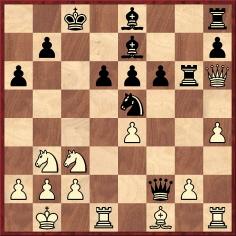
18 Qc1 Rhg8 19 Nd4 Bf8 20 b3 Rg3 21 Nce2 Re3 22 g3 Bh5 23 Rh2 Qxh2 24 Qxe3 Bg4 25 Rd2 Qh1 26 Qf2 Nf3 27 Nxf3 Qxf3 28 Qg1 Qxe4 29 Qa7 Bxe2 30 Bxe2 Bh6 31 Rd4 Qh1+ 32 Rd1 Qe4 33 Qa8+ Kc7 34 Qxg8 Qxe2 35 Qxh7+ Kc6 36 Qd3 Qe5 37 g4 Bg7 38 Qd4 f5 39 Qxe5 dxe5 40 g5 e4 41 h5 e3 42 h6 Bf8 43 Rh1 f4 44 Kc1 f3 45 Kd1 Bb4
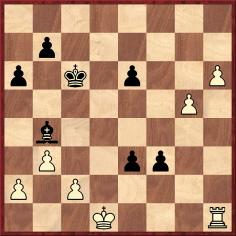
46 c3 Bxc3 47 Kc2 e2 48 Kxc3 f2 49 White resigns.
Source: Journal de Rouen, 20 June and 4 July 1935.
From Michael Clapham (Ipswich, England):
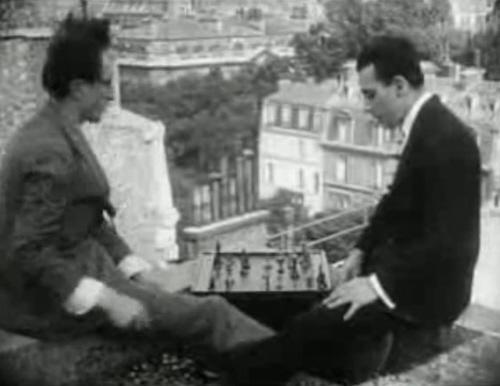
‘Man Ray and Marcel Duchamp played a game of Dadaist Chess in René Clair’s 1924 film Entr’acte. The whole work, about 20 minutes in duration, can be watched on-line. The chess scene starts at 4’29” and lasts about 40 seconds.’
(8366)
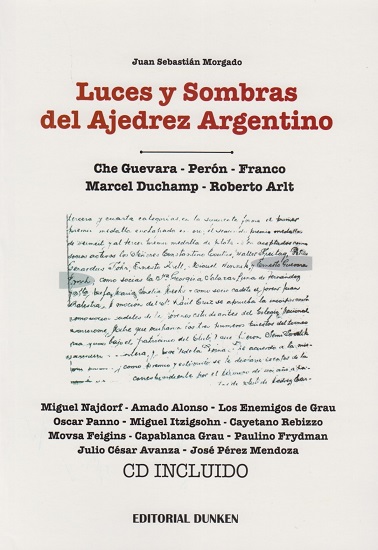
A particularly interesting recent book is Luces y Sombras del Ajedrez Argentino by Juan Sebastián Morgado (Buenos Aires, 2014). Highlights include the sections on Che Guevara (pages 13-44), Marcel Duchamp (pages 95-109), Movsa Feigins (pages 212-227) and Adolf Seitz (pages 239-267). The chapter on pages 284-293 offers ‘la versión definitiva’ of a controversy which arose regarding Capablanca v Grau, Buenos Aires, 1939.
(9042)
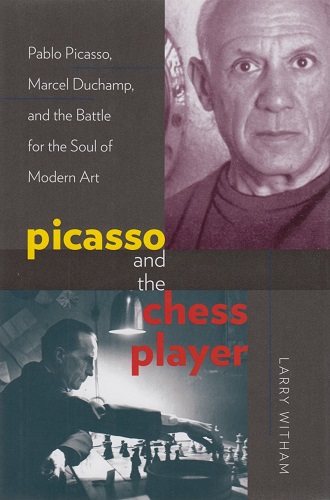
Picasso and the Chess Player by Larry Witham (Lebanon, 2013) cannot be recommended for its chess content, as on page 159:
‘When Duchamp entered the chess world, all the great moves, problems, and end games had been covered. These could be learned in books, which were a chief source for Duchamp’s self-education.’
The paragraph then refers to ‘José Raúl Casablanca’ (the book’s constant spelling), and the next page has this about Duchamp:
‘In Hamburg he came full circle. He played the US champion Frank Marshall, leading to a draw, which was better than a loss. At the International Paris Tournament he beat the Belgian champion and drew his match with the top winner of the competition.’
Page 327 mentions a book written by Duchamp with Halberstadt ‘to analyze a rare end game when only two kings remain’.
(9080)
From Oliver Beck (Seattle, WA, USA):
‘In “Echecs et Maths”, an essay on pages 42-51 of Marcel Duchamp: abécédaire, approches critiques edited by Jean Clair (Paris, 1977), François Le Lionnais claimed that although he and Marcel Duchamp were brought together through Dada and a strong philosophical and artistic affinity, their long friendship ultimately resulted from a shared interest in chess. He then provided an interesting summary of Duchamp’s chess career.
On pages 46-47 Le Lionnais gave some background information on his win over Duchamp during the Fifth Tournament of the Cercle Caïssa in 1932, a game published on pages 24-26 of the January 1933 Wiener Schachzeitung with Tartakower’s annotations. It was this game that prompted Ralph Rumney to interview Le Lionnais about Duchamp’s chess, and that resulted in Rumney’s “Marcel Duchamp as a Chess Player and One or Two Related Matters”, which was originally published in Studio International (January-February 1975). The interview, which can be found on pages 196-199 of The Map is Not the Territory by Rumney and Alan Woods (Manchester, 2000), is often cited in the many discussions on the correlation between Duchamp’s art and chess, and particularly regarding the common assertion that an avant-garde artist would naturally be a proponent of hypermodern chess. With this in mind, Rumney’s own observations about chess become especially interesting. On pages 85-87 of his autobiographical work Le Consul (Paris, 1999) he described playing chess with Duchamp at a reception following an art event:
“Il m’a dit: Allons dans la pièce d’à côté. Il y avait un échiquier créé par Max Ernst. J’avais créé un jeu d’échecs que je préfère à celui de Max Ernst. Il a aujourd’hui disparu dans la nature, mais l’un de mes projets avant de mourir est de le retrouver ou de le recréer. Duchamp m’a dit: Est-ce que tu sais jouer aux échecs? Comme ça on peut causer. Pendant le jeu, il a commencé à tendre de petits pièges. Il s’est laissé battre. Je joue aux échecs d’une manière très ordinaire. Les échecs, ce n’est pas un jeu d’intelligence mais un jeu de mémoire et de calcul. C’est comme le poker, comme presque tous les jeux dits de hasard que l’homme a su inventer, c’est bête comme ses pieds. Si tu sais retenir tout ce qu’il faut, tu gagnes. Si tu as la mémoire qui flanche, tu perds.”
In “Echecs et Maths” Le Lionnais mentioned too that his friendship with Duchamp was consolidated through their mutual admiration of Raymond Roussel.
An event not referred to in “Echecs et Maths” is a simultaneous exhibition in which Alekhine faced 36 teams in Paris on 15 June 1935. Details of the event are on page 60 of Le Lionnais’ Le Jardin des échecs (Paris, 1936), and the next two pages published Alekhine’s loss (included on page 526 of the Skinner/Verhoeven book on Alekhine) to Equipe de VU, a team consisting of Le Lionnais, Mmes Vogel and Melikoff, MM. Casciani, Melikoff and Wissiotzky.
C.N. 7796 gave Alekhine’s loss to the team comprising Pierre Biscay, Marcel Berman and Duchamp. Alekhine’s overall result was +27 –6 =3.
Page 46 of “Echecs et math” had a photograph of the French chess team (Kahn, Alekhine, Betbeder, Duchamp and Voisin) on a balcony during the 1933 International Team Tournament in Folkestone.’
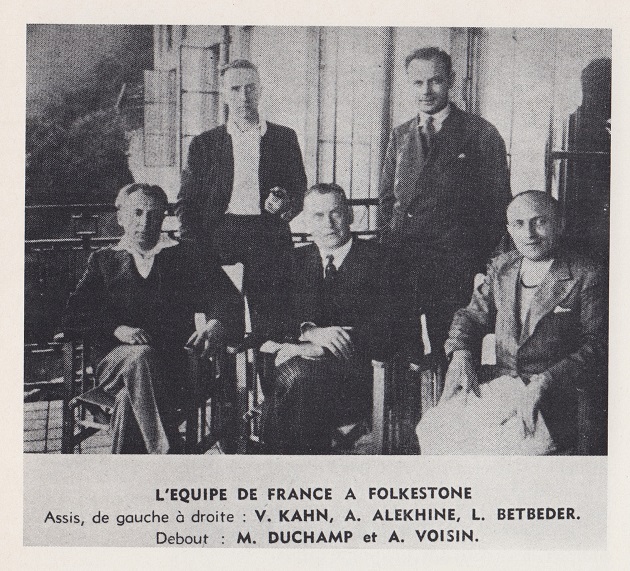
(9465)
From Oliver Beck:
‘I have come across an article written by Raymond Keene entitled “Chips with a pinch of salt: Duchamp and Le Lionnais” which appeared online in The Article (thearticle.com), dated 7 December 2024. It contains material taken from C.N. 9465 with no mention of you or Chess Notes. However, Mr Keene did credit me with at least some of it, describing me as “the late Oliver Beck of Seattle”.’
(12102)
Oliver Beck writes:
‘André Breton’s Le Surréalisme au service de la révolution, number 2, published in October 1930, included an item by Marcel Duchamp entitled “Formule de l’opposition hétérodoxe dans les domaines principaux” (pages 18-19). It consisted of six chess diagrams with accompanying text which prefigured pages 80-81 of the book which he wrote in collaboration with Vitaly Halberstadt, L’opposition et les cases conjuguées sont réconciliées (Brussels, 1932).
Parenthetically labeled “D’un livre à paraître: L’opposition et les cases conjuguées sont réconciliées”, Duchamp’s article may be viewed as an attempt to promote the project. In a letter to Katherine Dreier dated 18 December 1930 and published on pages 171-172 of Affectionately, Marcel: The Selected Correspondence of Marcel Duchamp edited by Francis M. Naumann and Hector Obalk (Ghent, 2000) Duchamp mentioned his continuing efforts to find a publisher for his book.
It nonetheless remains unclear why this fragment of a complex chess study appeared in a publication devoted to art and politics, and particularly considering Breton’s comment in Second Manifeste du surréalisme (Paris, 1930) regarding Duchamp’s career:
“Libre n’était pas à Duchamp d’abandonner la partie qu’il jouait aux environs de la guerre pour une partie d’échecs [Breton’s emphasis] interminable qui donne peut-être une idée curieuse d’une intelligence répugnant à servir [Breton’s emphasis] mais aussi – toujours cet exécrable Harrar – paraissant lourdement affligée de scepticisme dans la mesure où elle refuse de dire pourquoi.” (Page 64.)
With his reference to “exécrable Harrar”, Breton compared Duchamp’s apparent abandonment of art for chess to Rimbaud giving up poetry to become a trader in Abyssinia, a comparison which suggests that Breton saw a clear disconnect between art and chess.
Duchamp did refer to chess as an artistic endeavor, however. One example is found on page 55 of Observations by Richard Avedon and Truman Capote (New York, 1959) where Duchamp, quoted by Capote, commented on L’opposition et les cases conjuguées sont réconciliées:
“It has to do with blocked pawns, when your only means of winning is by moves of kings. This happens only once in a thousand times. And why, ... why isn’t my chess playing an art activity? A chess game is very plastic. You construct it. It’s mechanical sculpture and with chess one creates beautiful problems and that beauty is made with the head and hands.”
In an address made in 1952 at a banquet of the New York State Chess Association, quoted on page 72 of the third revised edition of The Complete Works of Marcel Duchamp by Arturo Schwarz (New York, 2000), Duchamp discussed the relationship between chess and art in some detail, concluding with the observation that “while all artists are not chess players, all chess players are artists”.
It is also noteworthy that Duchamp’s piece in Breton’s publication included an ending by Rinaldo Bianchetti. As discussed in C.N. 6004, Duchamp and Halberstadt were accused of plagiarizing Bianchetti’s Contributo alla teoria dei finali di soli pedoni (Florence, 1925).’
(10000)
Further to C.N. 7192 (see too The Chess Opening 1 h4), Harrie Grondijs writes:
‘Page 14 of the catalogue of a 1983 exhibition of works by Beatrice Wood (1893-1998) has a 1917 drawing of Marcel Duchamp playing chess with Francis Picabia:
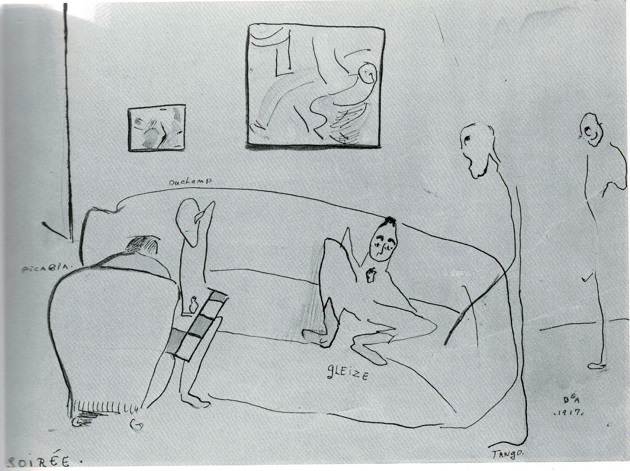
The accompanying text on page 14:
“Wood’s many drawings from this period provide us with the most complete and succinct visual record of the New York DADA group. In a drawing entitled Soirée of 1917 (fig. 8) we find Duchamp and Picabia intently engaged in a game of chess, while further down on the couch the French Cubist painter Albert Gleizes is sprawled out, staring obliviously into space. A fourth man labeled Tango appears to observe the progress of the chess match, while a fifth unidentified figure lurks mysteriously in the background.”
The catalogue also has, on page 23, a photograph of Duchamp, Picabia and Wood (Coney Island, 21 June 1917).’
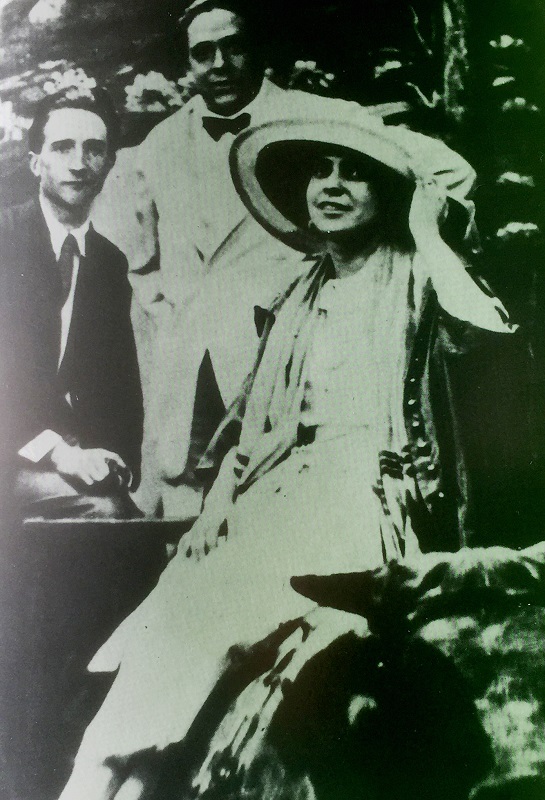
(10313)
Guy Gignac (Donnacona, Canada) seeks information about this photograph which he owns (and, particularly, positive identification of Marcel Duchamp on the right):
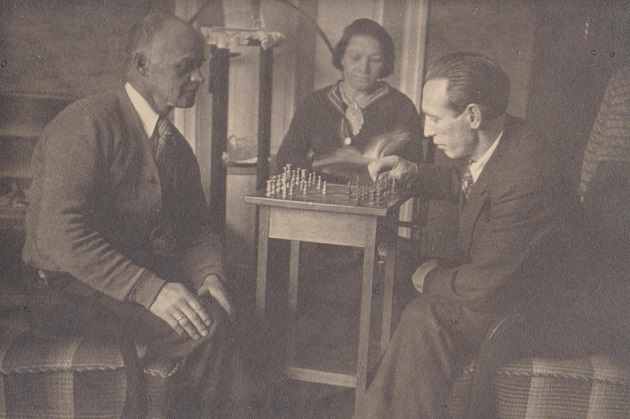
(10338)
Eduardo Bauzá Mercére (New York, NY, USA) reports that in January 2019 he took these photographs of the Bar Oscar, calle Adolfo Alsina 1745, Buenos Aires (which, in 2017, was named the ‘Sitio Marcel Duchamp/Francisco Canaro’):
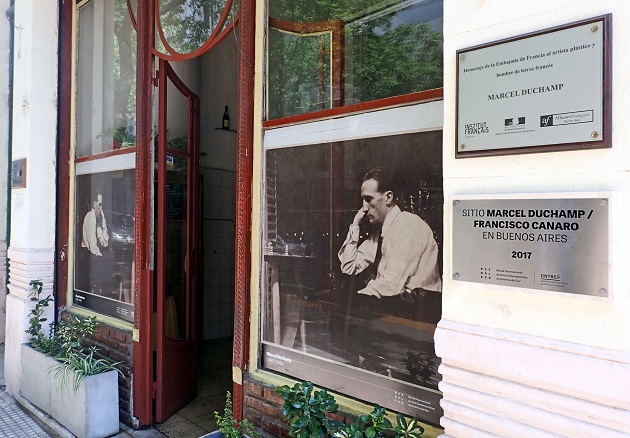
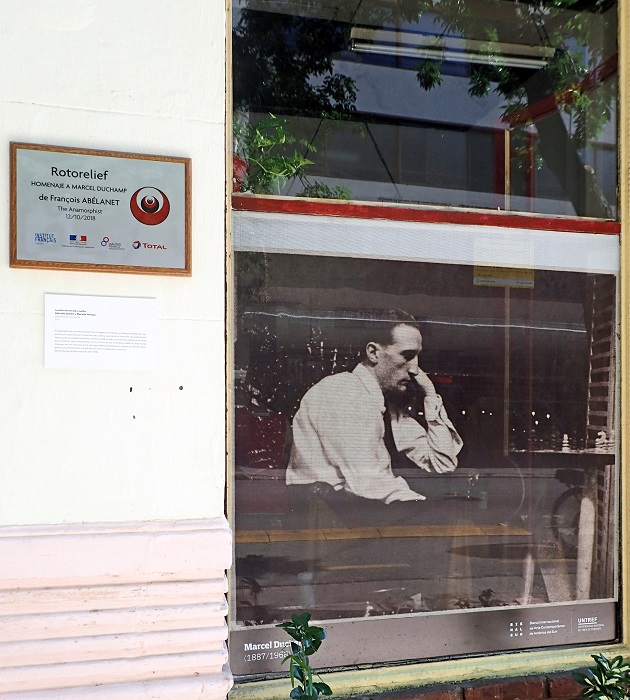
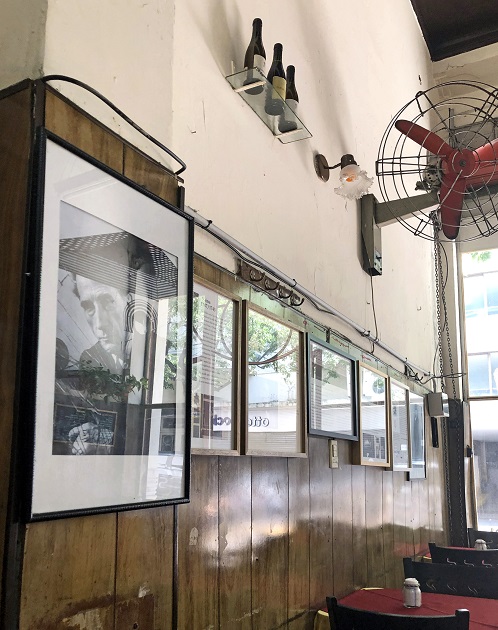
(11726)
From page 135 of Jump in the Waves by Jacqueline Piatigorsky (New York, 1988):
‘I continued to play chess and went to the club from time to time. ... In chess one deals with a cross-section of people. I played with a gardener and I played with Marcel Duchamp and Prokofiev ...’
Marcel Duchamp is numbered 18 in the 1928 photograph taken in The Hague:

To the Chess Notes main page.
To the Archives for other feature articles.
Copyright: Edward Winter. All rights reserved.